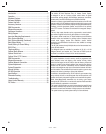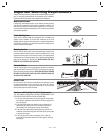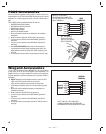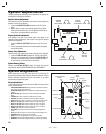
10
220777 C IMAGE 10
Relay Output Wiring
Any of the four relay outputs channels (A-D) can be used to control
access devices on doors or gates.
Door or Pedestrian Gate Control
1. Install a low voltage electric door strike or magnetic lock as a
locking device for the door or pedestrian gate.
2. Install the power supply or transformer for the locking device. DO
NOT POWER THE AE-1000 FROM THIS POWER SUPPLY.
3. Connect one wire from the power supply to one wire from the
locking device.
4. Route two wires between the locking device and the AE-1000.
Connect one wire to the remaining wire of the locking device.
Connect the other wire to the remaining wire of the power supply.
5A. For a door strike, connect the wires to the AE-1000 relay COM &
N.O. terminals.
5B. For a magnetic lock, connect the wires to the AE-1000 relay COM
& N.C. terminals.
Gate Control
1. Route two wires between the gate and the AE-1000.
2. Connect the gate operator’s OPEN terminals to the AE-1000 relay
COM & N.O. terminals.
✦ NOTE: For operator wiring specifi cs, refer to the gate operator’s
wiring diagram.
Request-to-Exit Inputs
Each of the four relay outputs has a request-to-exit input terminal.
Grounding this terminal will activate the associated relay. Exit request
inputs are typically used with push bars, loop sensors, or pushbuttons.
1. Install the pushbutton or device to signal an exit request.
2. Route two wires from the device to the AE-1000.
3. Connect the device’s normally open output to the wires.
4. To activate a relay channel, connect the wires to the associated
relay request-to-exit terminal (RTE-A, RTE-B, RTE-C, or RTE-D)
and GND terminals.
Sensing Inputs
The sensing inputs can connect to a door switch that monitors whether
the controlled door is open or closed.
1. To use the door sense feature to detect forced entry or door ajar
conditions, install a normally closed door switch on the door
or pedestrian gate and route two wires from the switch to the
AE-1000.
2. Connect the sensing device wires to the associated relay sensing
terminal (DS-A, DS-B, DS-C, or DS-D) and GND terminals.
GND
DS
N.O.
COM
N.C.
RTE
RELAY RATING:
3 AMPS @ 30 VOLTS
AC/DC MAXIMUM
TYPICAL DOOR STRIKE HOOKUP
TYPICAL MAGNETIC LOCK HOOKUP
TYPICAL AUTOMATIC GATE HOOKUP
ELECTRIC
DOOR
STRIKE
DOOR
STRIKE
POWER SUPPLY
GND
DS
N.O.
COM
N.C.
RTE
MAGNETIC
DOOR
LOCK
DOOR
LOCK
POWER SUPPLY
GND
DS
N.O.
COM
N.C.
RTE
GATE
OPERATOR
OPEN
RELAY
TERMINALS
GATE
EXIT LOOP
SENSOR
DOOR
SENSE
CONTACT
GND
DS
N.O.
COM
N.C.
RTE
RELAY
TERMINALS
NOTE: DOOR
SENSE CONTACT
IS NORMALLY CLOSED
DS = SENSING INPUT
RTE = REQUEST-TO-EXIT
DOOR EXIT
REQUEST
BUTTON
OR
NOTE: DOOR EXIT REQUEST BUTTON
AND GATE EXIT LOOP CONTACT
ARE NORMALLY OPEN


















